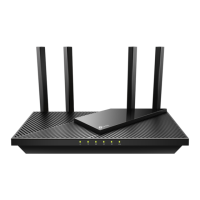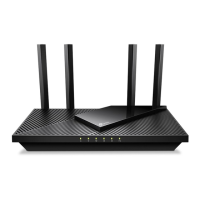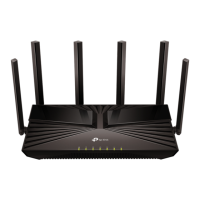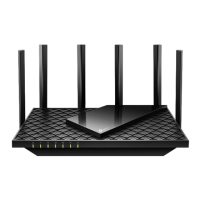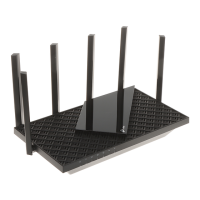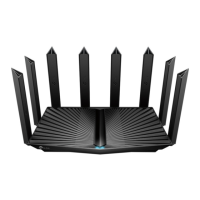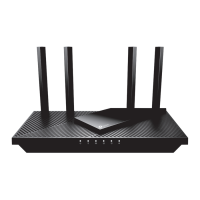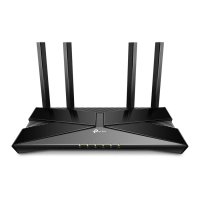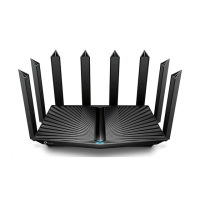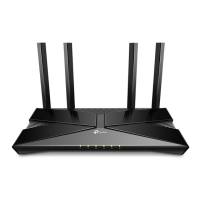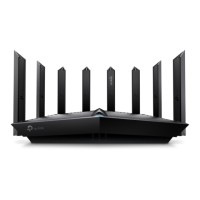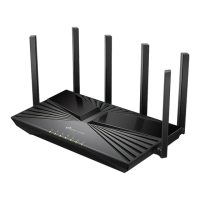Do you have a question about the TP-Link Archer AX55 and is the answer not in the manual?
Details the router's Wi-Fi 6 technology, throughput, and compatibility.
Describes the physical layout and components of the router.
Explains the LEDs on the router's top panel and their indications.
Details the ports and buttons located on the rear of the router.
Provides a detailed explanation of each button and port on the router.
Offers guidance on optimal placement of the router for best performance and safety.
Provides step-by-step instructions for physically connecting the modem and router.
Walks users through a guided setup process for internet connection configuration.
Explains how to configure internet connection using the mobile Tether app.
Details manual configuration steps for various internet connection types like Dynamic IP, PPPoE.
Instructions on configuring the router to extend an existing wired network wirelessly.
Guide for setting up internet connection using IPv6 protocols if supported by ISP.
Steps to create a TP-Link ID for cloud-based router management and services.
Instructions on modifying the email address and password associated with a TP-Link ID.
How to add or remove TP-Link IDs for managing the router with different user roles.
Using the Tether app for convenient remote management of the router.
Customizing SSID, password, security options, and advanced wireless features.
Setting a schedule for the router's Wi-Fi to automatically turn on or off.
Easy method to connect devices using Wi-Fi Protected Setup (WPS) with PIN or button.
Adjusting parameters like WMM, AP Isolation, Airtime Fairness, Beacon Interval, etc.
Setting up a separate Wi-Fi network for guests with custom SSID and password.
Configuring permissions for guest network access, like allowing them to see each other.
Connecting and accessing files on USB storage devices connected to the router.
Enabling DLNA for streaming media from USB storage to other devices.
Configuring the router to back up Mac computer data using Time Machine.
Tools for protecting the network from attacks, including IoT protection and intrusion prevention.
Setting restrictions on internet access for family members, like time limits and content blocking.
Analyzing network usage, quality of service, and running performance scans.
Creating a unified Wi-Fi network with extenders for seamless roaming.
Viewing and managing mesh devices and connected clients within the OneMesh network.
Configuring the SPI Firewall to protect the router from unauthorized access and attacks.
Blocking or allowing specific devices to access the network using Blacklist or Whitelist.
Binding device IP addresses to MAC addresses to prevent ARP spoofing and unauthorized access.
Configuring Application Layer Gateway (ALG) settings for specific protocols like FTP, SIP.
Configuring port forwarding rules to make local services accessible from the internet.
Setting up port triggering to automatically open specific ports for applications like online games.
Setting up a DMZ host to expose a device to the internet with all ports open.
Enabling UPnP to automatically open ports for online gaming and real-time communication.
Setting up an OpenVPN server for secure remote access to the home network.
Configuring a PPTP VPN server for remote access, offering ease of use.
Modifying the router's LAN IP address and subnet mask for network customization.
Setting up the router for IPTV services, including IGMP proxy and VLAN configuration.
Configuring the DHCP server, IP address pool, and address reservation for client devices.
Configuring DDNS to access the router remotely using a domain name instead of an IP address.
Manually configuring routing entries to direct network traffic to specific destinations.
Instructions for updating the router's firmware via auto update, online, or local file.
Saving current router settings to a file and restoring them when needed.
Procedures for changing the router's web management login password.
Setting up a password recovery mechanism via email for forgotten login passwords.
Controlling access to the router's web management interface from the local network using MAC addresses.
Enabling and configuring remote access to the router's web management interface over the internet.
Saving and sending system logs for troubleshooting network issues or monitoring router status.
Using Ping or Traceroute tools to diagnose network connectivity problems.
Configuring the router's system time and language settings for proper operation.
Scheduling automatic reboots for the router to maintain performance.
Enabling Night Mode to turn off the router's LED indicators during specific periods.
Details the router's Wi-Fi 6 technology, throughput, and compatibility.
Describes the physical layout and components of the router.
Explains the LEDs on the router's top panel and their indications.
Details the ports and buttons located on the rear of the router.
Provides a detailed explanation of each button and port on the router.
Offers guidance on optimal placement of the router for best performance and safety.
Provides step-by-step instructions for physically connecting the modem and router.
Walks users through a guided setup process for internet connection configuration.
Explains how to configure internet connection using the mobile Tether app.
Details manual configuration steps for various internet connection types like Dynamic IP, PPPoE.
Instructions on configuring the router to extend an existing wired network wirelessly.
Guide for setting up internet connection using IPv6 protocols if supported by ISP.
Steps to create a TP-Link ID for cloud-based router management and services.
Instructions on modifying the email address and password associated with a TP-Link ID.
How to add or remove TP-Link IDs for managing the router with different user roles.
Using the Tether app for convenient remote management of the router.
Customizing SSID, password, security options, and advanced wireless features.
Setting a schedule for the router's Wi-Fi to automatically turn on or off.
Easy method to connect devices using Wi-Fi Protected Setup (WPS) with PIN or button.
Adjusting parameters like WMM, AP Isolation, Airtime Fairness, Beacon Interval, etc.
Setting up a separate Wi-Fi network for guests with custom SSID and password.
Configuring permissions for guest network access, like allowing them to see each other.
Connecting and accessing files on USB storage devices connected to the router.
Enabling DLNA for streaming media from USB storage to other devices.
Configuring the router to back up Mac computer data using Time Machine.
Tools for protecting the network from attacks, including IoT protection and intrusion prevention.
Setting restrictions on internet access for family members, like time limits and content blocking.
Analyzing network usage, quality of service, and running performance scans.
Creating a unified Wi-Fi network with extenders for seamless roaming.
Viewing and managing mesh devices and connected clients within the OneMesh network.
Configuring the SPI Firewall to protect the router from unauthorized access and attacks.
Blocking or allowing specific devices to access the network using Blacklist or Whitelist.
Binding device IP addresses to MAC addresses to prevent ARP spoofing and unauthorized access.
Configuring Application Layer Gateway (ALG) settings for specific protocols like FTP, SIP.
Configuring port forwarding rules to make local services accessible from the internet.
Setting up port triggering to automatically open specific ports for applications like online games.
Setting up a DMZ host to expose a device to the internet with all ports open.
Enabling UPnP to automatically open ports for online gaming and real-time communication.
Setting up an OpenVPN server for secure remote access to the home network.
Configuring a PPTP VPN server for remote access, offering ease of use.
Modifying the router's LAN IP address and subnet mask for network customization.
Setting up the router for IPTV services, including IGMP proxy and VLAN configuration.
Configuring the DHCP server, IP address pool, and address reservation for client devices.
Configuring DDNS to access the router remotely using a domain name instead of an IP address.
Manually configuring routing entries to direct network traffic to specific destinations.
Instructions for updating the router's firmware via auto update, online, or local file.
Saving current router settings to a file and restoring them when needed.
Procedures for changing the router's web management login password.
Setting up a password recovery mechanism via email for forgotten login passwords.
Controlling access to the router's web management interface from the local network using MAC addresses.
Enabling and configuring remote access to the router's web management interface over the internet.
Saving and sending system logs for troubleshooting network issues or monitoring router status.
Using Ping or Traceroute tools to diagnose network connectivity problems.
Configuring the router's system time and language settings for proper operation.
Scheduling automatic reboots for the router to maintain performance.
Enabling Night Mode to turn off the router's LED indicators during specific periods.
| DSL WAN | No |
|---|---|
| Ethernet WAN | Yes |
| WAN connection type | RJ-45 |
| Wi-Fi band | Dual-band (2.4 GHz / 5 GHz) |
| Wi-Fi standards | 802.11a, 802.11b, 802.11g, Wi-Fi 4 (802.11n), Wi-Fi 5 (802.11ac), Wi-Fi 6 (802.11ax) |
| Top Wi-Fi standard | Wi-Fi 6 (802.11ax) |
| WLAN data transfer rate (max) | 2976 Mbit/s |
| WLAN data transfer rate (first band) | 574 Mbit/s |
| WLAN data transfer rate (second band) | 2402 Mbit/s |
| VPN server | OpenVPN, PPTP |
| Cabling technology | 10/100/1000Base-T(X) |
| Ethernet LAN data rates | 1000 Mbit/s |
| Ethernet LAN interface type | Gigabit Ethernet |
| Number of guest networks (5 GHz) | 1 |
| Ethernet LAN (RJ-45) ports | 4 |
| Security algorithms | WPA, WPA-Enterprise, WPA2, WPA2-Enterprise, WPA3 |
| Supported network protocols | IPv4, IPv6 |
| Product type | Tabletop router |
| Product color | Black |
| Internal memory | 512 MB |
| Processor cores | 2 |
| Output current | 2 A |
| Output voltage | 12 V |
| Power source type | AC |
| Operating temperature (T-T) | 0 - 40 °C |
| Operating relative humidity (H-H) | 10 - 90 % |
| Browser supported | Internet Explorer 11+, Firefox 12.0+, Chrome 20.0+, Safari 4.0+ |
| Cables included | LAN (RJ-45) |
| Package depth | 240 mm |
| Package width | 330 mm |
| Package height | 73 mm |
| Package weight | 940 g |
| Number of products included | 1 pc(s) |
| Sustainability certificates | RoHS, Federal Communications Commission (FCC), CE |
| Harmonized System (HS) code | 85176990 |
| Depth | 134.5 mm |
|---|---|
| Width | 261.1 mm |
| Height | 41 mm |
